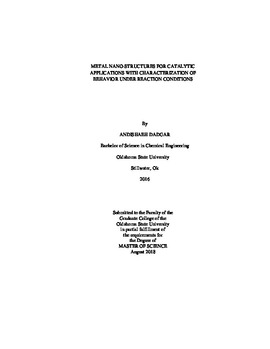| dc.contributor.advisor | Andiappan, Marimuthu | |
| dc.contributor.author | Dadgar, Andishaeh | |
| dc.date.accessioned | 2019-03-20T19:09:57Z | |
| dc.date.available | 2019-03-20T19:09:57Z | |
| dc.date.issued | 2018-08-01 | |
| dc.identifier.uri | https://hdl.handle.net/11244/317616 | |
| dc.description.abstract | Metal nanostructures are being used for more applications than ever before. Greater understanding of these structures for use in catalysis as well as energy transfer for bimetallic catalyst needs greater focus to drive rational design for future processes. By combining finite difference time domain simulations (FDTD) with experimental techniques, understanding of well-defined metal nanostructures may be gained under relevant conditions such as synthesis and reactions. In order to characterize these metal nanostructures under relevant conditions, Sonogashira coupling has been chosen to serve as a model reaction system with Au and Cu nanoparticles used as catalyst. Experimental results were found to closely correlate with FDTD simulation results for both growth of Au nanostructures and leaching under reaction conditions. CID(Chemical Interface Damping) is the primary energy transfer mechanism in Cu2O/Cu structures but DET (Direct Electron Transfer) and RET (Resonant Energy Transfer) are still possible. In Sonogashira coupling, copper nanoparticles were found to act as a precursor for homogenous catalyst in the presence of base. Without base, the particles were found to be stable with the reaction proceeding heterogeneously on the surface of copper nanoparticles. FDTD simulations were correlated with known imaging techniques and experimental data, therefore a quick effective tool has been developed to determine particle size and shape without using electron microscopy or x-ray techniques. By understanding CID to be the dominate transfer mechanism in bimetallic structures, future bimetallic structures can be designed to harness light more effectively. Rational design can now be applied for future structures with tunable energy transfer. Finally, Sonogashira coupling can be performed without the addition of base, palladium, or phosphine ligands. This opens the possibility to improve other cross coupling reactions with heterogeneous nanoparticle catalyst. | |
| dc.format | application/pdf | |
| dc.language | en_US | |
| dc.rights | Copyright is held by the author who has granted the Oklahoma State University Library the non-exclusive right to share this material in its institutional repository. Contact Digital Library Services at lib-dls@okstate.edu or 405-744-9161 for the permission policy on the use, reproduction or distribution of this material. | |
| dc.title | Metal Nano-structures for Catalytic Applications with Characterization of Behavior Under Reaction Conditions | |
| dc.contributor.committeeMember | Shah, Jindal K. | |
| dc.contributor.committeeMember | Kaan, Kalkan | |
| dc.contributor.committeeMember | Ramsey, Joshua D. | |
| osu.filename | Dadgar_okstate_0664M_15852.pdf | |
| osu.accesstype | Open Access | |
| dc.description.department | Chemical Engineering | |
| dc.type.genre | Thesis | |
| dc.type.material | text | |
